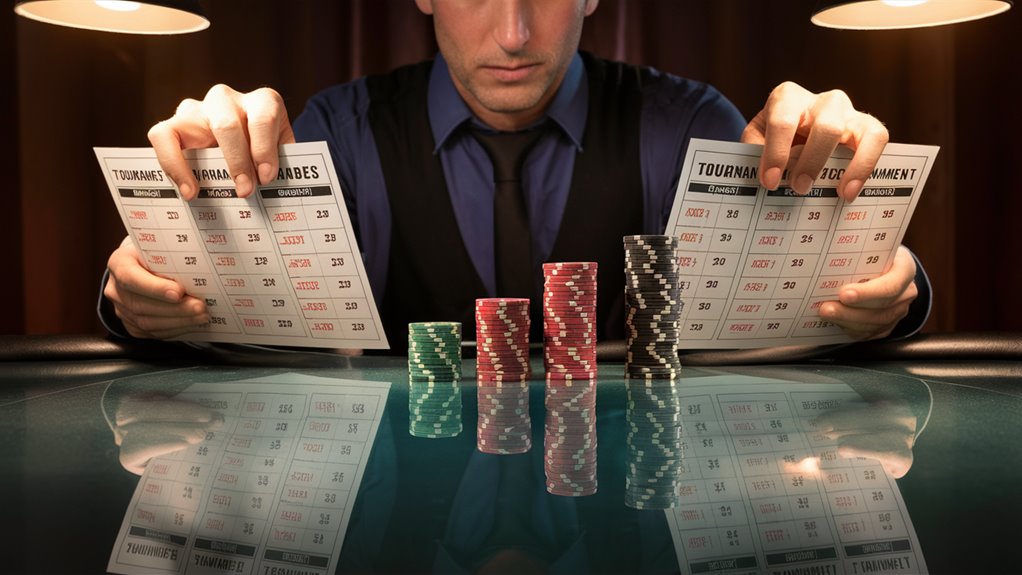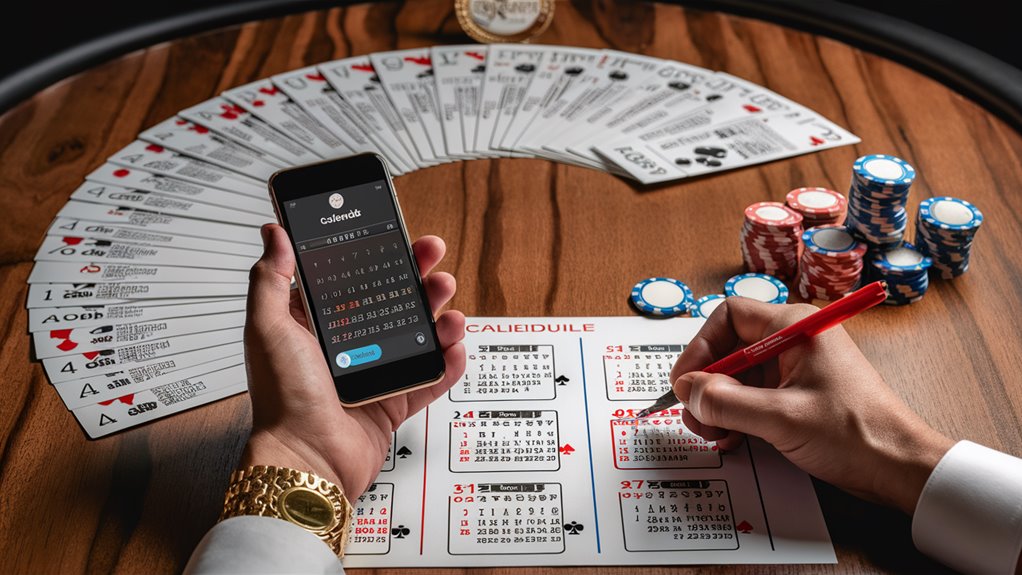
How to Pick the Best Poker Game for Your Skill

Bankroll Care and What to Pay
Smart bankroll care is key when picking poker games. Cap your payment at 5% of your full bankroll to keep in the game. Players good at $1/2 cash games should aim for games in the $100-200 range, keeping risk low but still aiming for good returns. 이 내용을 꼭 확인해보세요
Best Game Setup
Game sizes matter a lot. Pick games with 200-500 players for the best mix of risk and reward, and aim to land in the money 15-20% of the time. Look for games with 100+ big blind starting stacks and 20-30 minute blind levels for more space to use your skills.
Time Use and Plans
Playing in a tournament takes a lot of time. Before you join, think about:
- How long the game lasts
- When you get to rest
- How late you can sign up
- When it might end
Better Game Picks
Think about these key points to pick the best game:
- How blinds go up
- Who else is playing
- How prizes are split
- Can you try again if out early
- How many blinds you start with
Look at these parts to set yourself up for the most money from poker games.
Know Your Poker Strength
How to Check Your Own Poker Strength
Your Basic Skills
Knowing basic poker rules is a must before playing. Work at getting better at:
- Figuring out pot odds
- Moves based on your spot
- Knowing bet patterns
- Guessing others’ hands
Watch your game results for at least 100 tries.
Look at your win rate in normal games or ROI (Return on Investment) in tournaments.
Players who do well at $1/2 have a good shot in $100-200 entry games.
Game Skills Overview
Deep Dive on Game Setup
- How well you last in long games
- Adapting to blind changes
- Handling your stack at different points
- Making chip count moves
Your Poker Focus
- Keeping your cool
- Handling your emotions
- Not tilting under stress
- Making good choices fast
How to Manage Your Money
Good money care is the base for doing well in games. Key points:
- Keep at least 100 buy-ins for the game level you choose
- Watch for changes in what you win or lose
- Keep an eye on risk
- Set firm losing limits
Knowing these points helps pick the right game and stops you from moving up too fast, a common way to lose money in serious poker.
What You Pay to Play
All About Entry Costs
Getting What You Pay for
Picking the right game cost range is key to keeping your money safe while still aiming for good wins.
The main rule is to keep game costs at 5% of your full bankroll. For a $1,000 stack, stick to games that cost no more than $50.
Costs Based on How Good You Are
If You’re Just Starting
Low-cost games ($5-$25) are best for learning while keeping risk low. These games help you understand game flow, player moves, and basic tactics.
If You Know What You’re Doing
Players with good records should go for middle-cost games ($50-$200).
Keep at least 20 buy-ins in your stack for cover against ups and downs. A $4,000 stack means you can keep playing at the $200 level.
If You Are a Pro
Pros can try high-cost games ($200-$1,000), while keeping each game cost under 10% of total bankroll.
Big games shift a lot, so more money is needed than with standard games.
Picking the Right Game
Use a mix of different game costs like:
- Focusing mostly on one cost level
- Trying pricier games now and then
- Keeping strict money rules
- Choosing different types of games
This mixed way helps balance risk and reward while protecting your money from big swings.
Looking at Game Sizes
Analyzing How Many Play: Effects on Money and Moves
How Many Players Matter
Game size really changes your money-making chances (ROI) and how you play.
In games of 50-100 people, skilled players win money about 15-20% of the time, while huge games with over 1,000 players drop this chance to 10-12%. These rates are key to picking your games.
Best Game Size for You
The best place to build your bankroll is in small games. These games usually have:
- More casual players
- Easy to understand prize splits
- More chances to win cash
- Chances for bold moves early on
Big Game Tips
Very big games need different moves:
- Prize shapes that need you to aim to win
- Gathering chips is key in the middle part
- You need to take smart risks
- You need a big bankroll to handle shifts
Your Best Size
Mid-sized games (200-500 players) have the best balance:
- Big enough prize pools
- You can manage the number of players
- Fair shot at winning cash
- Good mix of risk and possible wins
- Even prize splits
These games are great for using advanced moves while keeping a steady chance at making money.
Blinds and When They Change
Mastering Game Blinds and Timing

Basic Blind Setup
Game blind setups and timing are key for making money and shaping your moves.
The mix of when blinds go up and how long levels last sets the basic rules for your game plan.
Quick games with 10-15 minute levels need bold, fast moves, while slower games with 20-30 minute levels let you play more complex moves after the flop.
Best Blind Changes
How blinds change needs care to max out your play time.
The best setups boost blinds by 50-100% each level, keeping you from losing chips too fast.
How you start with blinds is a big deal – the best games give you at least 100 big blinds to start, letting you play your full game.
Smart Ante Moves
When and how much you ante changes the game a lot and how long your stack lasts.
Starting anteing early makes the game move but ups stack stress at the same rate.
The most even setups start antes around levels 4-5, giving you time to get set before costs go up.
The best setup depends on how much money and time you have while maxing out your strategic edge.
How Prizes Split
How Money Divides: A Strategy Guide
Understanding Game Splits
How prize money divides really shapes your game plan and how much money you could make (ROI).
Looking at how cash splits before you sign up is key.
Top-heavy setups put a lot of cash in first place, pushing you to play hard.
On the other hand, flatter splits spread cash more evenly, letting you play more safely and aim just to get to the prize bubble.
Judging Game Worth
Lowest Cash Checks
Seeing how the smallest cash compares to what you pay tells you a lot about the game’s value. A $100 game that pays $120 for the lowest cash spot gives just a 20% ROI.
The best games give you at least twice your buy-in for making money spots.
How Many Get Paid
Look at the part of the field that gets cash:
- Normal range: 10-15% of players
- Safer setup: 20%+ (better for keeping a steady bankroll)
- High-win setup: Under 10% (needs bigger prize jumps)
Matching Game Choices
Your game picks should match:
- Your play style
- How you handle your money
- What risks you’re okay with
- Your ROI needs
The right prize setup varies based on how you plan to play and your money goals.
Deep know-how of how cash splits lets you pick the best games and max out what you can make.
Online or Live
Online vs Live Poker Games: Full Strategy Guide
The Big Differences in Game Types
Online poker games and live poker events bring different chances for players wanting to do their best in poker.
Online spots have big pluses with lower cost games, small running costs, and you can play many tables at once.
The faster pace online gives more hands each hour, making more chances for skilled players to use what they know.
Pluses of Playing Online
Online poker spots give great value by:
- Letting you play many tables, upping how much you can make each hour
- Cutting costs for trips and stays
- Fast game speed and quick game ends
- Lower cost games help with money care
- Easy to mix in tracking tools
Why Live Games Can Be Good
Live poker games bring unique pluses despite higher costs:
- You can watch others bet and spot tells
- You can make a big impact at the table and mess with others’ heads
- Deep plays and smart timing
- Fancy spots and big money pots
- Face-to-face games build key poker skills
How to Move Up in Games
New poker players should start with online games, using lower costs to learn basic plays.
As you get better, adding live game play is key for full poker growth.
Top players use both online and live games, using online spots for regular wins and learning, and live games for big prizes and growing as a pro.
Picking Games and Watching Your Money
Pro game players do their best by smart event picks and careful money watching.
Online games are good for learning and steady wins, while live ones are for big wins and meeting other pros.
Planning Your Game Times
Best Game Time Plans
Key Points for Best Money Returns
How long a game goes, how blinds change, and how you start with chips are key to doing well in games.
Seeing how these parts fit helps you see if a game matches when you can play and how you like to play.
Quick games need bold moves but have more up and downs, and that could hurt how much you make over time.
Why Multi-Day Games Are Worth It
Multi-day games give more room for smart plays and showing your skills.
Think about other costs like stays and food when you work out what a game really costs.
Playing your best means setting game times with when you do best, and making sure you rest and know when it’ll end. How to Choose the Best Betting Strategy for Your Gambling Goals
How to Handle Playing Again
Rules for joining again shape how you plan and how much money you need.
Work out your most you’ll spend, thinking about playing again, before you join a game.
Games that let you try to get in cheap are good for planning your game costs and making the most money you can.
More Game Points to Think About
- How long rounds last
- Your starting blinds compared to chips
- Can you sign up late
- How often you get to rest and for how long
- What level each day aims to reach
- Paths for getting into big games cheap


